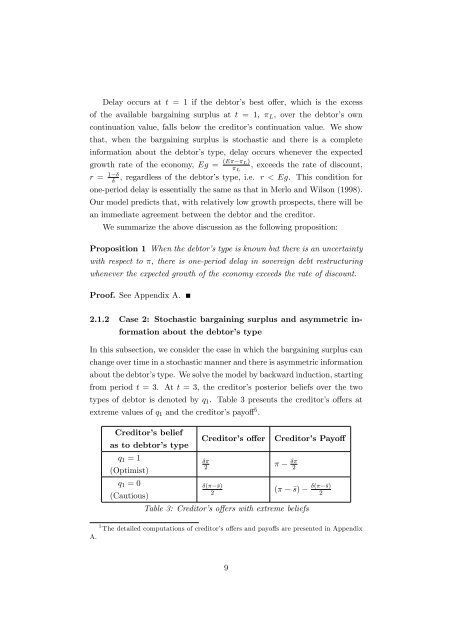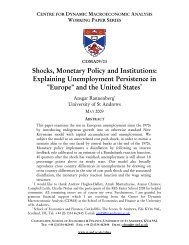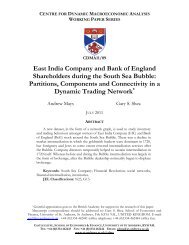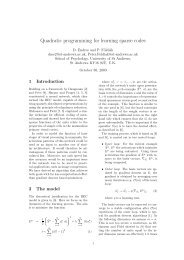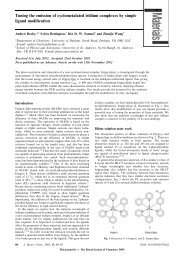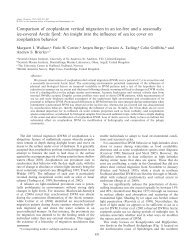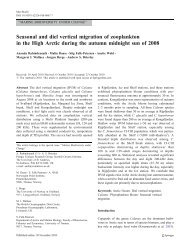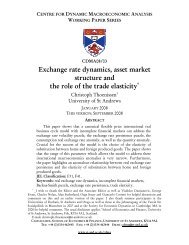Delay and Haircuts in Sovereign Debt - University of St Andrews
Delay and Haircuts in Sovereign Debt - University of St Andrews
Delay and Haircuts in Sovereign Debt - University of St Andrews
Create successful ePaper yourself
Turn your PDF publications into a flip-book with our unique Google optimized e-Paper software.
<strong>Delay</strong> occurs at t = 1 if the debtor’s best o¤er, which is the excess<br />
<strong>of</strong> the available barga<strong>in</strong><strong>in</strong>g surplus at t = 1, L , over the debtor’s own<br />
cont<strong>in</strong>uation value, falls below the creditor’s cont<strong>in</strong>uation value. We show<br />
that, when the barga<strong>in</strong><strong>in</strong>g surplus is stochastic <strong>and</strong> there is a complete<br />
<strong>in</strong>formation about the debtor’s type, delay occurs whenever the expected<br />
growth rate <strong>of</strong> the economy, Eg = (E L)<br />
L<br />
, exceeds the rate <strong>of</strong> discount,<br />
r = 1 , regardless <strong>of</strong> the debtor’s type, i.e. r < Eg. This condition for<br />
<br />
one-period delay is essentially the same as that <strong>in</strong> Merlo <strong>and</strong> Wilson (1998).<br />
Our model predicts that, with relatively low growth prospects, there will be<br />
an immediate agreement between the debtor <strong>and</strong> the creditor.<br />
We summarize the above discussion as the follow<strong>in</strong>g proposition:<br />
Proposition 1 When the debtor’s type is known but there is an uncerta<strong>in</strong>ty<br />
with respect to , there is one-period delay <strong>in</strong> sovereign debt restructur<strong>in</strong>g<br />
whenever the expected growth <strong>of</strong> the economy exceeds the rate <strong>of</strong> discount.<br />
Pro<strong>of</strong>. See Appendix A.<br />
2.1.2 Case 2: <strong>St</strong>ochastic barga<strong>in</strong><strong>in</strong>g surplus <strong>and</strong> asymmetric <strong>in</strong>formation<br />
about the debtor’s type<br />
In this subsection, we consider the case <strong>in</strong> which the barga<strong>in</strong><strong>in</strong>g surplus can<br />
change over time <strong>in</strong> a stochastic manner <strong>and</strong> there is asymmetric <strong>in</strong>formation<br />
about the debtor’s type. We solve the model by backward <strong>in</strong>duction, start<strong>in</strong>g<br />
from period t = 3. At t = 3, the creditor’s posterior beliefs over the two<br />
types <strong>of</strong> debtor is denoted by q 1 . Table 3 presents the creditor’s o¤ers at<br />
extreme values <strong>of</strong> q 1 <strong>and</strong> the creditor’s payo¤ 5 .<br />
A.<br />
Creditor’s belief<br />
as to debtor’s type<br />
q 1 = 1<br />
(Optimist)<br />
q 1 = 0<br />
(Cautious)<br />
Creditor’s o¤er<br />
<br />
<br />
2<br />
<br />
2<br />
(<br />
s)<br />
2<br />
( s)<br />
Table 3: Creditor’s o¤ers with extreme beliefs<br />
Creditor’s Payo¤<br />
( s)<br />
2<br />
5 The detailed computations <strong>of</strong> creditor’s o¤ers <strong>and</strong> payo¤s are presented <strong>in</strong> Appendix<br />
9


